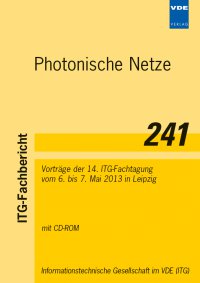Evaluation of Technology Options for Software-Defined Transceivers in Fixed WDM Grid versus Flexible WDM Grid Optical Transport Networks
Konferenz: Photonische Netze - Vorträge der 14. ITG-Fachtagung
06.05.2013 - 07.05.2013 in Leipzig, Germany
Tagungsband: Photonische Netze
Seiten: 5Sprache: EnglischTyp: PDF
Persönliche VDE-Mitglieder erhalten auf diesen Artikel 10% Rabatt
Autoren:
Autenrieth, A.; Elbers, J.-P.; Grobe, K.; Grießer, H. (ADVA Optical Networking SE, Fraunhoferstr. 9a, 82152 Martinsried / Munich, Germany)
Eiselt, M. (ADVA Optical Networking SE, Maerzenquelle 1-3, 98617 Meiningen, Germany)
Teipen, B. (ADVA Optical Networking Inc, 5755 Peachtree Industrial Blvd, Norcross, GA 30092, USA)
Inhalt:
Spectrum-efficient optical transmission with bitrates of 400 Gb/s and beyond can be achieved using flexible modulation with advanced DSPs. The technology options include modulation format, signal baud rate, number of subcarriers, and spectral bandwidth. A fine-granular spectral bandwidth requires a flexible WDM grid as recently defined by ITU-T. Transmission of a signal with multiple optical carriers, each potentially with their own set of modulation options, allows bandwidth-variable multi-flow transceivers. This can reduce the spectrum continuity constraint in the network. At the network layer, these new degrees of freedom create additional levels of complexity and constraints during network design, planning and operation. Which modulation constellation should be chosen for a new optical connection? What are the impacts on transmission reach, spectrum continuity constraints, and network utilization? Routing and spectrum assignment is becoming more complex, and the inevitable spectrum fragmentation reduces the spectral efficiency gained though efficient modulation schemes. Dynamic spectrum defragmentation requires transceivers supporting hitless defragmentation, or it is traffic affecting for the reallocated signals. The sheer number of technology options will increase the operational complexity of the network. In this paper, we give an overview of technology options for software-defined transceivers for fixed-grid and flex-grid optical transport networks, and their impact for network planning and operation. We evaluate the spectral network efficiency, and operational complexity of selected technology options, such as multi-carrier transmission in fixed WDM grid, bandwidth-variable transponders with multiple subcarriers in a flexible WDM grid, and fully flexible multi-flow transponders. The evaluation is done based on a network planning study on a national European and US reference network. Based on the evaluation result, a guideline is given for a technology strategy with a good balance between flexibility, spectrum efficiency, and network cost.


